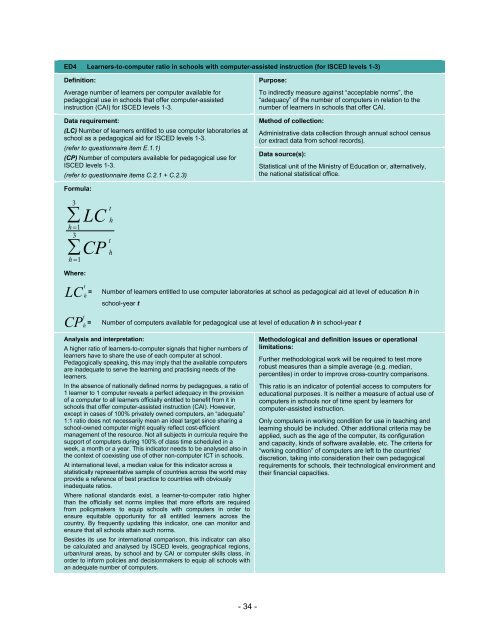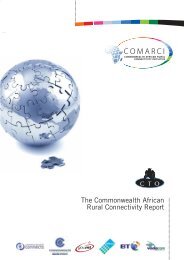Guide to measuring information and ... - unesdoc - Unesco
Guide to measuring information and ... - unesdoc - Unesco
Guide to measuring information and ... - unesdoc - Unesco
Create successful ePaper yourself
Turn your PDF publications into a flip-book with our unique Google optimized e-Paper software.
ED4 Learners-<strong>to</strong>-computer ratio in schools with computer-assisted instruction (for ISCED levels 1-3)<br />
Definition:<br />
Average number of learners per computer available for<br />
pedagogical use in schools that offer computer-assisted<br />
instruction (CAI) for ISCED levels 1-3.<br />
Data requirement:<br />
(LC) Number of learners entitled <strong>to</strong> use computer labora<strong>to</strong>ries at<br />
school as a pedagogical aid for ISCED levels 1-3.<br />
(refer <strong>to</strong> questionnaire item E.1.1)<br />
(CP) Number of computers available for pedagogical use for<br />
ISCED levels 1-3.<br />
(refer <strong>to</strong> questionnaire items C.2.1 + C.2.3)<br />
Formula:<br />
3<br />
LC<br />
h 1<br />
3<br />
CP<br />
h 1<br />
Where:<br />
t<br />
h<br />
t<br />
h<br />
- 34 -<br />
Purpose:<br />
To indirectly measure against “acceptable norms”, the<br />
“adequacy” of the number of computers in relation <strong>to</strong> the<br />
number of learners in schools that offer CAI.<br />
Method of collection:<br />
Administrative data collection through annual school census<br />
(or extract data from school records).<br />
Data source(s):<br />
Statistical unit of the Ministry of Education or, alternatively,<br />
the national statistical office.<br />
LC t<br />
= Number of learners entitled <strong>to</strong> use computer labora<strong>to</strong>ries at school as pedagogical aid at level of education h in<br />
h<br />
school-year t<br />
CP t<br />
h = Number of computers available for pedagogical use at level of education h in school-year t<br />
Analysis <strong>and</strong> interpretation:<br />
A higher ratio of learners-<strong>to</strong>-computer signals that higher numbers of<br />
learners have <strong>to</strong> share the use of each computer at school.<br />
Pedagogically speaking, this may imply that the available computers<br />
are inadequate <strong>to</strong> serve the learning <strong>and</strong> practising needs of the<br />
learners.<br />
In the absence of nationally defined norms by pedagogues, a ratio of<br />
1 learner <strong>to</strong> 1 computer reveals a perfect adequacy in the provision<br />
of a computer <strong>to</strong> all learners officially entitled <strong>to</strong> benefit from it in<br />
schools that offer computer-assisted instruction (CAI). However,<br />
except in cases of 100% privately owned computers, an “adequate”<br />
1:1 ratio does not necessarily mean an ideal target since sharing a<br />
school-owned computer might equally reflect cost-efficient<br />
management of the resource. Not all subjects in curricula require the<br />
support of computers during 100% of class time scheduled in a<br />
week, a month or a year. This indica<strong>to</strong>r needs <strong>to</strong> be analysed also in<br />
the context of coexisting use of other non-computer ICT in schools.<br />
At international level, a median value for this indica<strong>to</strong>r across a<br />
statistically representative sample of countries across the world may<br />
provide a reference of best practice <strong>to</strong> countries with obviously<br />
inadequate ratios.<br />
Where national st<strong>and</strong>ards exist, a learner-<strong>to</strong>-computer ratio higher<br />
than the officially set norms implies that more efforts are required<br />
from policymakers <strong>to</strong> equip schools with computers in order <strong>to</strong><br />
ensure equitable opportunity for all entitled learners across the<br />
country. By frequently updating this indica<strong>to</strong>r, one can moni<strong>to</strong>r <strong>and</strong><br />
ensure that all schools attain such norms.<br />
Besides its use for international comparison, this indica<strong>to</strong>r can also<br />
be calculated <strong>and</strong> analysed by ISCED levels, geographical regions,<br />
urban/rural areas, by school <strong>and</strong> by CAI or computer skills class, in<br />
order <strong>to</strong> inform policies <strong>and</strong> decisionmakers <strong>to</strong> equip all schools with<br />
an adequate number of computers.<br />
Methodological <strong>and</strong> definition issues or operational<br />
limitations:<br />
Further methodological work will be required <strong>to</strong> test more<br />
robust measures than a simple average (e.g. median,<br />
percentiles) in order <strong>to</strong> improve cross-country comparisons.<br />
This ratio is an indica<strong>to</strong>r of potential access <strong>to</strong> computers for<br />
educational purposes. It is neither a measure of actual use of<br />
computers in schools nor of time spent by learners for<br />
computer-assisted instruction.<br />
Only computers in working condition for use in teaching <strong>and</strong><br />
learning should be included. Other additional criteria may be<br />
applied, such as the age of the computer, its configuration<br />
<strong>and</strong> capacity, kinds of software available, etc. The criteria for<br />
“working condition” of computers are left <strong>to</strong> the countries’<br />
discretion, taking in<strong>to</strong> consideration their own pedagogical<br />
requirements for schools, their technological environment <strong>and</strong><br />
their financial capacities.
















